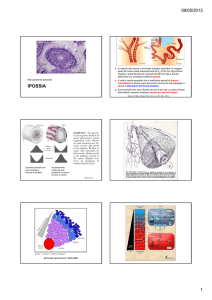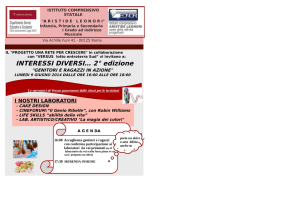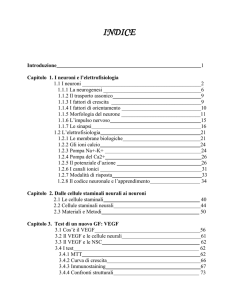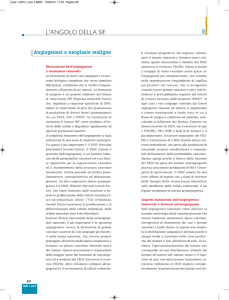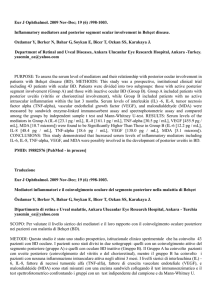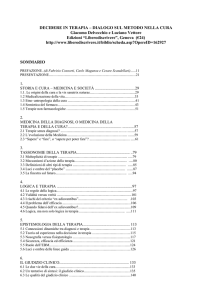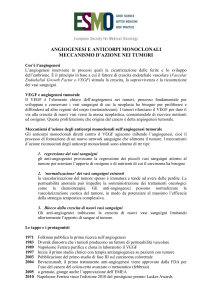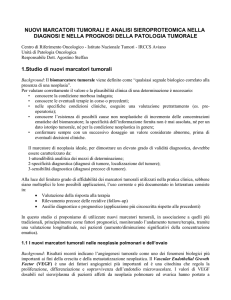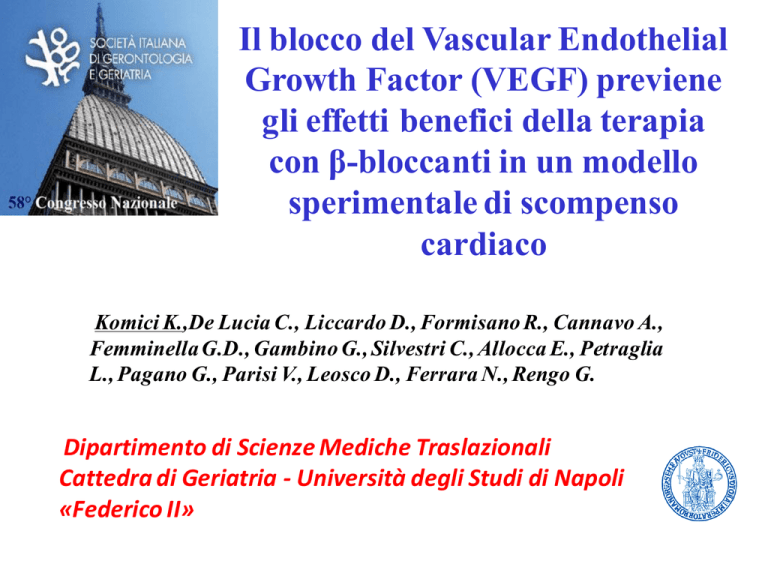
Il blocco del Vascular Endothelial
Growth Factor (VEGF) previene
gli effetti benefici della terapia
con β-bloccanti in un modello
sperimentale di scompenso
cardiaco
Komici K.,De Lucia C., Liccardo D., Formisano R., Cannavo A.,
Femminella G.D., Gambino G., Silvestri C., Allocca E., Petraglia
L., Pagano G., Parisi V., Leosco D., Ferrara N., Rengo G.
Dipartimento di Scienze Mediche Traslazionali
Cattedra di Geriatria - Università degli Studi di Napoli
«Federico II»
• Attualmente lo scompenso cardiaco è la
causa principale di morbidità e mortalità nei
pazienti con infarto miocardico pregresso
• La perdita della funzionalità cardiaca dopo
infarto miocardico induce : rimodellamento
cardiaco, ipertrofia compensatoria e
stimolazione della neoangiogenesi cardiaca.
• La terapia con β -bloccanti riduce le
riospedalizzazioni e la mortalità (Bristow, M.R.
2000. Circulation).
• I β -bloccanti inibiscono l'ipertono simpatico,
migliorano il rimodellamento cardiaco, riducono il
consumo di O2, riducono il rischio di aritmie,
inibiscono la internalizzazione dei β-AR.
• I β-bloccanti migliorano la perfusione miocardica
potenziando la neoangiogenesi nel cuore scompensato
(Dedkov, E.I., et al 2005 Circ Phsyiol.; Ulu, N., et al 2009
Cardiovasc Pharmacol; Christensen, L.P., 2009 Am J
Physiol)
• HRR attiva il VEGF ( Zheng, W., et al 1999 Circ Res)
• L’inibizione del signaling del VEGF è cruciale nella
transizione da ipertrofia compensatoria a rimodellamento
maladattivo (Shiojima, I., et al 2005 J Clin Invest)
Lo scopo dello studio:
• Valutare gli effetti dell’inibizione
dell’angiogenesi indotta dal β-bloccante.
Metodi
8 settimane
dopo IM
placebo
bisoprololo
Dati ecocardiografici a T0.
Left ventricular ejection fraction (EF), LV internal diameter at diastole LVIDd and Heart Rate measured by echocardiography at 8
weeks post MI before bisoprolol or placebo tratments initiation. (n=12) rats per group. Data are presented as mean ± SEM.*P<0.05
versus sham. One –way ANOVA analysis and Bonferroni test among all groups.
Dati clinici ed ecocardigrafici nei ratti sham e operati alla fine
dello studio
L’effetto del bisoprololo sulla fibrosi cardiaca
Fibrosis in cardiac section from all three experimental groups at the end of the study (n=5 for each group). Representative panels of picro-sirius red
staining (magnification x200) and average quantitative analysis Scale bar: 50 μm. Data are presented as mean ± SEM. *P<0.05 versus sham;
#P<0.05 versus HF; P<0.05 versus HF. One- way ANOVA analysis with Benferroni test among all groups.
L’effetto del bisoprololo sull’angiogenesi
Effects of bisoprolol on cardiac capillary and arteriol network. Representive images of Lectin Bandeiraea simplicifolia I
staining of capillaries and arterioles stained with antibodies agiants smooth muscle α-actin in cardiac section obtaiend from
sham. HF and HF/B rats at the end of the study period in the lateral wall far from the infarcted area (remote). Bar grafs show
data on capillay counts and arteriolar length density in either border or remote zones in all study period.(n=5 rats per group
and 5 sections per animal.
L’espressione cardiaca di VEGF, pAkt e peNOS
SHAM
HF
HF/B
SHAM
HF
HF/B
SHAM
HF
HF/B
Cardiac protein expression of VEGF, p-Akt, and peNOS in sham, HF, HF/B at the end of the study. The expression of GAPDH was used as an
internal control to normalize VEGF levels. p-Akt to total p-Akt ratio, and peNOS to total peNOS ratio indicated respectively the levels of Akt and
eNOS phsophorilation in the heart (n=5 hearts per group). Data are presented as mean ± SEM. *P<0.05 versus sham; #P<0.05 versus HF. One- way
ANOVA analysis with Benferroni test among all groups.
Bisoprololo e Ad-Flk
Placebo e Ad-Ctrl
Placebo e Ad-Flk
Bisoprololo e Ad-Ctrl
Dati clinici e ecocardiografici nei ratti
scompensati alla fine dello studio
L’effetto del bisoprololo e dell’inibizione del VEGF sulla
fibrosi cardiaca
HF/
AdCtr
HF/
AdFlk
HF/B/
AdCtr
HF/B/
AdFlk
Fibrosis in cardiac section from all four experimental groups at the end of the study (n=5 for each group). Representative panels of picro-sirius red
staining (magnification x200) and average quantitative analysis Scale bar: 50 μm. Data are presented as mean ± SEM. *P<0.05 versus all other
HF groups. One- way ANOVA analysis with Benferroni test among all groups.
L’effetto del bisoprololo e dell’inibizione del VEGF sull’
angiogenesi.
Effects of bisoprolol on cardiac capillary and arteriol network. Representive images of Lectin Bandeiraea simplicifolia I staining of capillaries and arterioles
stained with antibodies agiants smooth muscle α-actin in cardiac section obtaiend from sham. HF and HF/B rats at the end of the study period in the lateral wall
far from the infarcted area (remote). Bar grafs show data on capillay counts and arteriolar length density in either border or remote zones in all study period.(n=5
rats per group and 5 sections per animal. Data are presented as mean ± SEM. *P<0.05 versus all other HF groups.
L’espressione cardiaca di VEGF, pAkt e peNOS
HF/A
DCtrl
HF/
AD
-Flk
HF/B
/ADCtrl
HF/B
/ADFlk
HF/A
DCtrl
HF/A
DFlk
HF/B
/AD/
Ctrl
HF/B
/ADFlk
HF/A
DCtrl
HF/A HF/B/
DADFlk
Ctrl
HF/B/
ADFlk
Cardiac protein expression of VEGF, p-Akt, and peNOS in sham, HF, HF/B at the end of the study. The expression of GAPDH was used as an internal control
to normalize VEGF levels. p-Akt to total p-Akt ratio, and peNOS to total peNOS ratio indicated respectively the levels of Akt and eNOS phsophorilation in the
heart (n=5 hearts per group). Data are presented as mean ± SEM. *P<0.05 versus all other HF groups. One- way ANOVA analysis with Benferroni test among
all groups.
Conclusioni
• La terapia con β-bloccante induce la
neoangiogenesi nel cuore scompensato
attraverso l’attivazione del signaling del
VEGF
• L’effetto proangiogenico del β-bloccante è
essenziale per gli effetti terapeutici sulla
funzione ed il rimodellamento cardiaco.
Grazie!!!

